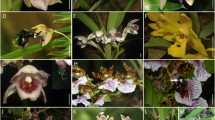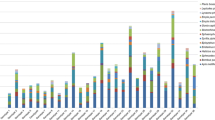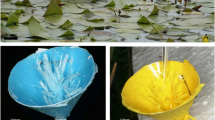Abstract
Cyclocephaline scarabs are specialised scent-driven pollinators, implicated with the reproductive success of several Neotropical plant taxa. Night-blooming flowers pollinated by these beetles are thermogenic and release intense fragrances synchronized to pollinator activity. However, data on floral scent composition within such mutualistic interactions are scarce, and the identity of behaviorally active compounds involved is largely unknown. We performed GC-MS analyses of floral scents of four species of Annona (magnoliids, Annonaceae) and Caladium bicolor (monocots, Araceae), and demonstrated the chemical basis for the attraction of their effective pollinators. 4-Methyl-5-vinylthiazole, a nitrogen and sulphur-containing heterocyclic compound previously unreported in flowers, was found as a prominent constituent in all studied species. Field biotests confirmed that it is highly attractive to both male and female beetles of three species of the genus Cyclocephala, pollinators of the studied plant taxa. The origin of 4-methyl-5-vinylthiazole in plants might be associated with the metabolism of thiamine (vitamin B1), and we hypothesize that the presence of this compound in unrelated lineages of angiosperms is either linked to selective expression of a plesiomorphic biosynthetic pathway or to parallel evolution.



Similar content being viewed by others
References
Armbruster, W. S., Keller, S., Matsuki, M., and Clausen, T. P. 1989. Pollination of Dalechampia magnoliifolia (Euphorbiaceae) by male euglossine bees. Am J. Bot. 76:1279–1285.
Azizian, M. F., Nelson, P. O., Thayumanavan, P., and Williamson, K. J. 2003. Environmental impact of highway construction and repair materials on surface and ground waters: Case study: crumb rubber asphalt concrete. Waste Manage. 23:719–728.
Azuma, H., Thien, L. B., and Kawano, S. 1999. Molecular phylogeny of Magnolia (Magnoliaceae) inferred from cpDNA sequences and evolutionary divergence of the floral scents. J. Plant Res. 112:291–306.
BEACH, J. H. 1982. Beetle pollination of Cyclanthus bipartitus (Cyclanthaceae). Am. J. Bot. 69:1074–1081.
Bengtsson, J. M., Wolde-Hawariat, Y., Khbaish, H., Negash, M., Jembere, B., Seyoum, E., Hansson, B. S., Larsson, M. C., and Hillbur, Y. 2009. Field attractants for Pachnoda interrupta selected by means of GC-EAD and single sensillum screening. J. Chem. Ecol. 35:1063–1076.
Bernhardt, P. 2000. Convergent evolution and adaptive radiation of beetle-pollinated angiosperms. Plant Syst. Evol. 222:293–320.
Brodmann, J., Twele, R., Francke, W., Yi-Bo, L., Xi-Qiang, S., and Ayasse, M. 2009. Orchid mimics honey bee alarm pheromone in order to attract hornets for pollination. Curr. Biol. 19:1368–1372.
CEPAGRI, 2012. Centro de Pesquisas Meteorológicas e Climáticas Aplicadas à Agricultura. <http://www.cpa.unicamp.br/>
Chen, C., Song, Q., Proffit, M., J-M, B., Li, Z., and Hossaert-Mckey, M. 2009. Private channel: a single unusual compound assures specific pollinator attraction in Ficus semicordata. Funct. Ecol. 23:941–950.
Chess, S. K. R., Raguso, R. A., and Lebuhn, G. 2008. Geographic divergence in floral morphology and scent in Linanthus dichotomus (Polemoniaceae). Am. J. Bot. 95:1652–1659.
Dieringer, G., Cabrera, L., Lara, M., Loya, L., and Reyes-Castillo, P. 1999. Beetle pollination and floral thermogenicity in Magnolia tamaulipana. Int. J. Plant Sci. 160:64–71.
Dieringer, G. and Espinosa, S. J. E. 1994. Reproductive ecology of Magnolia schiedeana (Magnoliaceae), a threatened cloud forest tree species in Veracruz. Mexico. Bull. Torrey Bot. Club 121:154–159.
DOBSON, H. E. M. 2006. Relationship between floral fragrance composition and type of pollinator, pp. 147–198, in N. Dudareva and E. Pichersky (eds.), Biology of Floral Scent. CRC Press, Boca Raton.
Dodson, C. H., Dressler, R. L., Hills, H. G., Adams, R. M., and WILLIAMS, N. H. 1969. Biologically active compounds in orchid fragrances. Science 164:1243–1249.
Dötterl, S., Jürgens, A., Seifert, K., Laube, T., Weißbecker, B., and Schütz, S. 2006. Nursery pollination by a moth in Silene latifolia: the role of odours in eliciting antennal and behavioural responses. New Phytologist 169:707–718.
Dötterl, S., Wolfe, L. M., and Jürgens, A. 2005. Qualitative and quantitative analyses of flower scent in Silene latifolia. Phytochemistry 66:203–213.
Eltz, T., Roubik, D. W., and Lunau, K. 2005. Experience-dependent choices ensure species-specific fragrance accumulation in male orchid bees. Behav. Ecol. Sociobiol. 59:149–156.
Engel, K. H. and Tressl, R. 1991. Identification of new sulphur-containing volatiles in yellow (Passiflora edulis f. flavicarpa). J. Agric. Food Chem 39:2249–2252.
Ervik, F. and Knudsen, J. T. 2003. Water lilies and scarabs: faithful partners for 100 million years? Biol. J. Linn. Soc. 80:539–543.
Ervik, F., Tollsten, L., and Knudsen, J. T. 1999. Floral scent chemistry and pollination ecology in phytelephantoid palms (Arecaceae). Plant Syst. Evol. 217:279–297.
Faegri, K. and van der Pijl, L. 1979. The Principles of Pollination Ecology (2nd Edition). Pergamon Press, New York.
FISCHER, N., Hammerschmidt, F.-J., and Brunke, E.-J. 1995. Analytical investigations of the flavor of cupuaçu (Theobroma grandiflorum Spreng.), pp. 8–20, in R. L. Rouseff and M. M. Leahy (eds.), Fruit Flavors: Biogenesis, Characterization, and Authentication (ACS Symposium Series Vol. 596). ACS Publications, Washington.
Gibernau, M., Barabé, D., Labat, D., Cerdan, P., and Dejean, A. 2003. Reproductive biology of Montrichardia arborescens (Araceae) in French Guiana. J. Trop. Ecol. 19:103–107.
Gibernau, M., Barabé, D., Cerdan, P., and Dejean, A. 1999. Beetle pollination of Philodendron solimoesense (Araceae) in French Guiana. Int. J. Plant Sci. 160:1135–1143.
Goeke, A. 2002. Sulfur-containing odorants in fragrance chemistry. Sulfur Reports 23:243–278.
GOODRICH, K. R. and Raguso, R. A. 2009. The olfactory component of floral display in Asimina and Deeringothamnus (Annonaceae). New Phytologist 183:457–469.
Gottsberger, G. 1986. Some pollination strategies in neotropical savannas and forests. Plant Syst. Evol. 152:29–45.
Gottsberger, G. 1989. Beetle pollination and flowering rhythm of Annona spp. (Annonaceae) in Brazil. Plant Syst. Evol. 167:165–187.
Gottsberger, G. 1990. Flowers and beetles in the South American tropics. Bot. Acta 103:360–365.
Gottsberger, G. and Silberbauer-Gottsberger, I. 1991. Olfactory and visual attraction of Erioscelis emarginata (Cyclocephalini, Dynastinae) to the inflorescences of Philodendron selloum (Araceae). Biotropica 23:23–28.
GOTTSBERGER, G., and Silberbauer-G2, I. 2006. Life in the Cerrado, a South American Seasonal Ecosystem. Vol. I. Origin, Structure, Dynamics and Plant Use. Reta, Ulm.
Gottsberger, G., Silberbauer-Gottsberger, I., Seymour, R. S., and Dötterl, S. 2012. Pollination ecology of Magnolia ovata may explain the overall large flower size of the genus. Flora 207:107–118.
ITEP, 2012. Instituto de Tecnologia de Pernambuco–Laboratorio de Meteorologia de Pernambuco. <http://www.itep.br/LAMEPE.asp>
Johnson, S. D. and Jürgens, A. 2010. Convergent evolution of carrion and faecal scent mimicry in fly-pollinated angiosperm flowers and a stinkhorn fungus. S. Afr. J. Bot. 76:796–807.
Jürgens, A., Dötterl, S., and Meve, U. 2006. The chemical nature of fetid floral odors in stapeliads (Apocynaceae-Asclepiadoideae-Ceropegieae). New Phytologist 172:452–468.
Jurgenson, C. T., Begley, T. P., and Ealick, S. E. 2009. The structural and biochemical foundations of thiamin biosynthesis. Annu. Rev. Biochem. 78:569–603.
Kaiser, R. 1993. The Scent of Orchids: Olfactory and Chemical Investigations, 1st ed. Elsevier Science, Amsterdam.
Kaiser, R. and Tollsten, L. 1995. An introduction to the scent of cacti. Flavour Fragr. J. 10:153–164.
Knudsen, J. T., Eriksson, R., Gershenzon, J., and Ståhl, B. 2006. Diversity and distribution of floral scent. Bot. Rev. 72:1–120.
Knudsen, J. T. and Tollsten, L. 1995. Floral scent in bat-pollinated plants - a case of convergent evolution. Bot. J. Linn. Soc. 119:45–57.
Maga, J. A. 1975. The role of sulfur compounds in food flavor. part I: Thiazoles. Crit. Rev. Food Sci 6:153–176.
MAIA, A. C. D. and Schlindwein, C. 2006. Caladium bicolor (Araceae) and Cyclocephala celata (Coleoptera, Dynastinae): a well-established pollination system in the northern Atlantic rainforest of Pernambuco, Brazil. Plant Biol. 8:529–534.
Maia, A. C. D., Schlindwein, C., Navarro, D. M. A. F., and Gibernau, M. 2010. Pollination of Philodendron acutatum (Araceae) in the Atlantic Forest of northeastern Brazil: a single scarab beetle species guarantees high fruit set. Int. J. Plant Sci. 171:740–748.
Peakall, R., Ebert, D., Poldy, J., Barrow, R. A., Francke, W., Bower, C. C., and Schiestl, F. P. 2010. Pollinator specificity, floral odour chemistry and the phylogeny of Australian sexually deceptive Chiloglottis orchids: implications for pollinator-driven speciation. New Phytologist 188:437–450.
Pichersky, E. and Lewinsohn, E. 2011. Convergent evolution in plant specialized metabolism. Annu. Rev. Plant Biol. 62:549–566.
Pichersky, E., Noel, J. P., and Dudareva, N. 2006. Biosynthesis of plant volatiles: nature’s diversity and ingenuity. Science 311:808–811.
Pino, J. A., Aguero, J., and Marbot, R. 2001. Volatile components of soursop (Annona muricata). J. Essent. Oil Res. 13:140–141.
Plepys, D., Ibarra, F., and Löfstedt, C. 2002. Volatiles from flowers of Platanthera bifolia (Orchidaceae) attractive to the silver Y moth, Autographa gamma (Lepidoptera: Noctuidae). Oikos 99:69–74.
RAGUSO, R. A. 2001. Floral scent, olfaction, and scent-driven foraging behavior, pp. 83–105, in L. Chittka and J. D. Thomson (eds.), Cognitive Ecology of Pollination. Cambridge University Press, Cambridge.
RAGUSO, R. A. 2008. Wake up and smell the roses: the ecology and evolution of floral scent. Annu. Rev. Ecol. Evol. Syst. 39:549–569.
Raguso, R. A. and Pellmyr, O. 1998. Dynamic headspace analysis of floral volatiles: a comparison of methods. Oikos 81:238–254.
Schatz, G. E. 1990. Some aspects of pollination biology in Central American forests, pp. 69–84, in K. S. Bawa and M. Hadley (eds.), Reproductive Ecology of Tropical Forest Plants. UNESCO/Parthenon, Paris.
SCHIESTL, F. P. 2010. The evolution of floral scent and insect chemical communication. Ecol. Lett. 13:643–656.
Schiestl, F. P., Ayasse, M., Paulus, H. F., Löfstedt, C., Hansson, B. S., Ibarra, F., and Francke, W. 1999. Orchid pollination by sexual swindle. Nature 399:421–422.
Schiestl, F. P., Peakall, R., Mant, J. G., Ibarra, F., Schulz, C., Franke, S., and Francke, W. 2003. The chemistry of sexual deception in an orchid-wasp pollination system. Science 302:437–438.
Schultz, K., Kaiser, R., and KNUDSEN, J. T. 1999. Cyclanthone and derivatives, new natural products in the flower scent of Cyclanthus bipartitus Poit. Flavour Fragr. J. 14:185–190.
Schwab, W., Davidovich-Rikanati, R., and Lewinsohn, E. 2008. Biosynthesis of plant-derived flavor compounds. Plant J. 54:712–732.
Schwerdtfeger, M., Gerlach, G., and Kaiser, R. 2002. Anthecology in the neotropical genus Anthurium (Araceae): a preliminary report. Selbyana 23:258–267.
Seymour, R. S., White, C. R., and Gibernau, M. 2003. Heat reward for insect pollinators. Nature 426:243–244.
Shuttleworth, A. and JOHNSON, S. D. 2010. The missing stink: sulphur compounds can mediate a shift between fly and wasp pollination systems. Proc. R. Soc. B 277:2811–2819.
Stensmyr, M. C., Urru, I., Collu, I., Celander, M., Hansson, B. S., and Angioy, A. M. 2002. Rotting smell of dead-horse arum florets - These blooms chemically fool flies into pollinating them. Nature 420:625–626.
Teichert, H., Dötterl, S., Zimma, B., Ayasse, M., and Gottsberger, G. 2009. Perfume-collecting male euglossine bees as pollinators of a basal angiosperm: the case of Unonopsis stipitata (Annonaceae). Plant Biol. 11:29–37.
Valdes, H. and ZAROR, C. A. 2006. Heterogeneous and homogeneous catalytic ozonation of benzothiazole promoted by activated carbon: kinetic approach. Chemosphere 65:1131–1136.
von Helversen, O., Winkler, L., and Bestmann, H. J. 2000. Sulphur-containing "perfumes" attract flower-visiting bats. J. Comp. Physiol. A 186:143–153.
Whitten, W. M., Williams, N. H., Armbruster, W. S., and Battiste, M. A. 1986. Carvone oxide: an example of convergent evolution in euglossine pollinated plants. Syst. Bot. 11:222–228.
Wong, K. C. and Khoo, K. H. 1993. Volatile components of Malaysian Annona fruits. Flavour Fragr. J. 8:5–10.
Yu, T. H., Wu, C. M., and Liou, Y. C. 1989. Volatile compounds from garlic. J. Agric. Food Chem. 37:725–730.
Acknowledgements
The authors thank Paschoal Coelho Grossi, Brett Ratcliffe, and Antônio Carlos Webber for species identification; and Roger Seymour, Kyle Dexter, Cecília Meira and three anonymous reviewers for proofreading and valuable suggestions. This work was partly supported by grants from CAPES, CNPq and BMBF.
Author information
Authors and Affiliations
Corresponding author
Rights and permissions
About this article
Cite this article
Maia, A.C.D., Dötterl, S., Kaiser, R. et al. The Key Role of 4-methyl-5-vinylthiazole in the Attraction of Scarab Beetle Pollinators: a Unique Olfactory Floral Signal Shared by Annonaceae and Araceae. J Chem Ecol 38, 1072–1080 (2012). https://doi.org/10.1007/s10886-012-0173-z
Received:
Revised:
Accepted:
Published:
Issue Date:
DOI: https://doi.org/10.1007/s10886-012-0173-z




